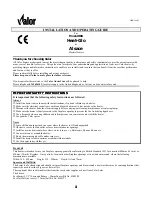
THERMOCOUPLE
The thermocouple may need replacement if the burner
goes out after allowing the thermocouple to heat up for an
extended period of time.
1.
Pull back on the thermocouple to disengage it from
its mounting bracket.
2.
Loosen the thermocouple connector nut which is
threaded into the safety control valve. Slide the
thermocouple through the bushing at the back of the
heater.
■
The thermocouple uses a clip to mount within its
support bracket. See Fig.8. Ensure the thermocouple
is completely pushed into its bracket. Failure to do so
may cause burner outage.
■
When connecting the thermocouple to the safety
control valve, thread the thermocouple finger tight to
the valve, then snug it in with a wrench.
To determine if the thermocouple is defective:
-- Connect an ohm meter between the ends of
the thermocouple.
-- A good thermocouple will show some level of
resistance from end to end.
-- A defective thermouple will show an open
circuit on the ohm meter
FIG. 8
12
IGNITER and ELECTRODE
Servicing of the igniter and electrode is needed when a spark
is not observed at the electrode when pushing the igniter
button. This may happen with hard use over a long period of
time, or due to dust and dirt accumulation.
If you do not see a spark being generated at the electrode
check the following areas:
A. Igniter
1.
Remove the wire from the push button igniter.
2.
Position a screwdriver tip) about 1/8 in. from igniter.See
Fig.9
3.
Holding the screwdriver by its handle, push the igniter’s
button several times. If spark is not seen, replace the
igniter. If spark is observed, proceed to electrode
servicing.
FIG. 9
B. Electrode
1.
Ensure the wire between the electrode and the igniter is
securely connected.
2.
Check the wire for nicks, cuts, or mars. Nicks or cuts
will prevent a spark from being generated at the
electrode tip. Replace the electrode if necessary. The
electrode ships with the wire.
3.
Ensure electrode tip is 5/32 in. (.156) from inside of
burner. Clean the electrode with emery cloth or steel
wool. See Fig.10.
4.
Verify that the electrode’s insulator body is not cracked
and that the electrode rod does not move within its the
body. See Fig.11. If it does, replace the electrode.
REMOVE NUT TO REPLACE IGNITER
FIG. 10
FIG. 11
INSULATOR
TIP GAP: 5/32 IN.
CLEAN-USE EMERY CLOTH
Содержание Workman CV225
Страница 16: ...16 Parts Identification Parts Schematic ...




































